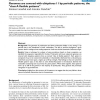Free Online Productivity Tools
i2Speak
i2Symbol
i2OCR
iTex2Img
iWeb2Print
iWeb2Shot
i2Type
iPdf2Split
iPdf2Merge
i2Bopomofo
i2Arabic
i2Style
i2Image
i2PDF
iLatex2Rtf
Sci2ools
BMCBI
2005
2005
Genomes are covered with ubiquitous 11 bp periodic patterns, the "class A flexible patterns"
Background: The genomes of prokaryotes and lower eukaryotes display a very strong 11 bp periodic bias in the distribution of their nucleotides. This bias is present throughout a given genome, both in coding and non-coding sequences. Until now this bias remained of unknown origin. Results: Using a technique for analysis of auto-correlations based on linear projection, we identified the sequences responsible for the bias. Prokaryotic and lower eukaryotic genomes are covered with ubiquitous patterns that we termed "class A flexible patterns". Each pattern is composed of up to ten conserved nucleotides or dinucleotides distributed into a discontinuous motif. Each occurrence spans a region up to 50 bp in length. They belong to what we named the "flexible pattern" type, in that there is some limited fluctuation in the distances between the nucleotides composing each occurrence of a given pattern. When taken together, these patterns cover up to half of the genome in the m...
BMCBI 2005 | Bp Periodic Bias | Genomes | Nucleotides |
| Added | 15 Dec 2010 |
| Updated | 15 Dec 2010 |
| Type | Journal |
| Year | 2005 |
| Where | BMCBI |
| Authors | Etienne Larsabal, Antoine Danchin |
Comments (0)

